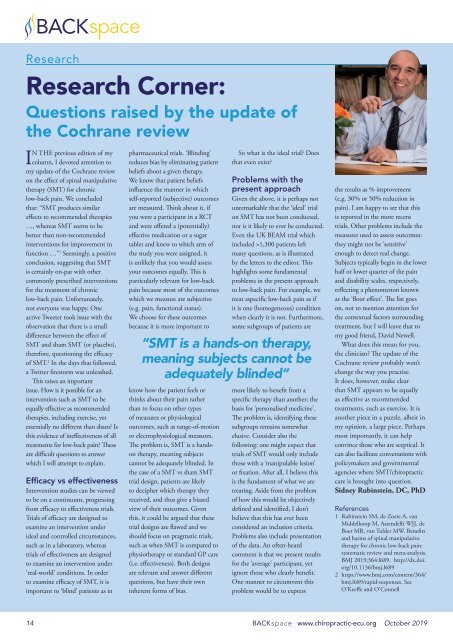Backspace Oct19
Backspace Oct19
Backspace Oct19
Create successful ePaper yourself
Turn your PDF publications into a flip-book with our unique Google optimized e-Paper software.
Research<br />
Research Corner:<br />
Questions raised by the update of<br />
the Cochrane review<br />
IN THE previous edition of my<br />
column, I devoted attention to<br />
my update of the Cochrane review<br />
on the effect of spinal manipulative<br />
therapy (SMT) for chronic<br />
low-back pain. We concluded<br />
that: “SMT produces similar<br />
effects to recommended therapies<br />
…, whereas SMT seems to be<br />
better than non-recommended<br />
interventions for improvement in<br />
function …” 1 Seemingly, a positive<br />
conclusion, suggesting that SMT<br />
is certainly on-par with other<br />
commonly prescribed interventions<br />
for the treatment of chronic<br />
low-back pain. Unfortunately,<br />
not everyone was happy. One<br />
active Tweeter took issue with the<br />
observation that there is a small<br />
difference between the effect of<br />
SMT and sham SMT (or placebo),<br />
therefore, questioning the efficacy<br />
of SMT. 2 In the days that followed,<br />
a Twitter firestorm was unleashed.<br />
This raises an important<br />
issue. How is it possible for an<br />
intervention such as SMT to be<br />
equally effective as recommended<br />
therapies, including exercise, yet<br />
essentially no different than sham? Is<br />
this evidence of ineffectiveness of all<br />
treatments for low-back pain? These<br />
are difficult questions to answer<br />
which I will attempt to explain.<br />
Efficacy vs effectiveness<br />
Intervention studies can be viewed<br />
to be on a continuum, progressing<br />
from efficacy to effectiveness trials.<br />
Trials of efficacy are designed to<br />
examine an intervention under<br />
ideal and controlled circumstances,<br />
such as in a laboratory, whereas<br />
trials of effectiveness are designed<br />
to examine an intervention under<br />
‘real-world’ conditions. In order<br />
to examine efficacy of SMT, it is<br />
important to ‘blind’ patients as in<br />
pharmaceutical trials. ‘Blinding’<br />
reduces bias by eliminating patient<br />
beliefs about a given therapy.<br />
We know that patient beliefs<br />
influence the manner in which<br />
self-reported (subjective) outcomes<br />
are measured. Think about it, if<br />
you were a participant in a RCT<br />
and were offered a (potentially)<br />
effective medication or a sugar<br />
tablet and knew to which arm of<br />
the study you were assigned, it<br />
is unlikely that you would assess<br />
your outcomes equally. This is<br />
particularly relevant for low-back<br />
pain because most of the outcomes<br />
which we measure are subjective<br />
(e.g. pain, functional status).<br />
We choose for these outcomes<br />
because it is more important to<br />
know how the patient feels or<br />
thinks about their pain rather<br />
than to focus on other types<br />
of measures or physiological<br />
outcomes, such as range-of-motion<br />
or electrophysiological measures.<br />
The problem is, SMT is a handson<br />
therapy, meaning subjects<br />
cannot be adequately blinded. In<br />
the case of a SMT vs sham SMT<br />
trial design, patients are likely<br />
to decipher which therapy they<br />
received, and thus give a biased<br />
view of their outcomes. Given<br />
this, it could be argued that these<br />
trial designs are flawed and we<br />
should focus on pragmatic trials,<br />
such as when SMT is compared to<br />
physiotherapy or standard GP care<br />
(i.e. effectiveness). Both designs<br />
are relevant and answer different<br />
questions, but have their own<br />
inherent forms of bias.<br />
So what is the ideal trial? Does<br />
that even exist?<br />
Problems with the<br />
present approach<br />
Given the above, it is perhaps not<br />
unremarkable that the ‘ideal’ trial<br />
on SMT has not been conducted,<br />
nor is it likely to ever be conducted.<br />
Even the UK BEAM trial which<br />
included >1,300 patients left<br />
many questions, as is illustrated<br />
by the letters to the editor. This<br />
highlights some fundamental<br />
problems in the present approach<br />
to low-back pain. For example, we<br />
treat aspecific low-back pain as if<br />
it is one (homogeneous) condition<br />
when clearly it is not. Furthermore,<br />
some subgroups of patients are<br />
“SMT is a hands-on therapy,<br />
meaning subjects cannot be<br />
adequately blinded”<br />
more likely to benefit from a<br />
specific therapy than another; the<br />
basis for ‘personalised medicine’.<br />
The problem is, identifying these<br />
subgroups remains somewhat<br />
elusive. Consider also the<br />
following: one might expect that<br />
trials of SMT would only include<br />
those with a ‘manipulable lesion’<br />
or fixation. After all, I believe this<br />
is the fundament of what we are<br />
treating. Aside from the problem<br />
of how this would be objectively<br />
defined and identified, I don’t<br />
believe that this has ever been<br />
considered an inclusion criteria.<br />
Problems also include presentation<br />
of the data. An often-heard<br />
comment is that we present results<br />
for the ‘average’ participant, yet<br />
ignore those who clearly benefit.<br />
One manner to circumvent this<br />
problem would be to express<br />
the results as % improvement<br />
(e.g. 30% or 50% reduction in<br />
pain). I am happy to see that this<br />
is reported in the more recent<br />
trials. Other problems include the<br />
measures used to assess outcomes:<br />
they might not be ‘sensitive’<br />
enough to detect real change.<br />
Subjects typically begin in the lower<br />
half or lower quarter of the pain<br />
and disability scales, respectively,<br />
reflecting a phenomenon known<br />
as the ‘floor effect’. The list goes<br />
on, not to mention attention for<br />
the contextual factors surrounding<br />
treatment, but I will leave that to<br />
my good friend, David Newell.<br />
What does this mean for you,<br />
the clinician? The update of the<br />
Cochrane review probably won’t<br />
change the way you practise.<br />
It does, however, make clear<br />
that SMT appears to be equally<br />
as effective as recommended<br />
treatments, such as exercise. It is<br />
another piece in a puzzle, albeit in<br />
my opinion, a large piece. Perhaps<br />
most importantly, it can help<br />
convince those who are sceptical. It<br />
can also facilitate conversations with<br />
policymakers and governmental<br />
agencies where SMT/chiropractic<br />
care is brought into question.<br />
Sidney Rubinstein, DC, PhD<br />
References<br />
1 Rubinstein SM, de Zoete A, van<br />
Middelkoop M, Assendelft WJJ, de<br />
Boer MR, van Tulder MW. Benefits<br />
and harms of spinal manipulative<br />
therapy for chronic low-back pain:<br />
systematic review and meta-analysis.<br />
BMJ 2019;364:l689. http://dx.doi.<br />
org/10.1136/bmj.l689<br />
2 https://www.bmj.com/content/364/<br />
bmj.l689/rapid-responses. See<br />
O’Keeffe and O’Connell<br />
14 BACKspace www.chiropractic-ecu.org October 2019<br />
01-32 <strong>Backspace</strong> <strong>Oct19</strong>.indd 14 10/09/2019 16:14





